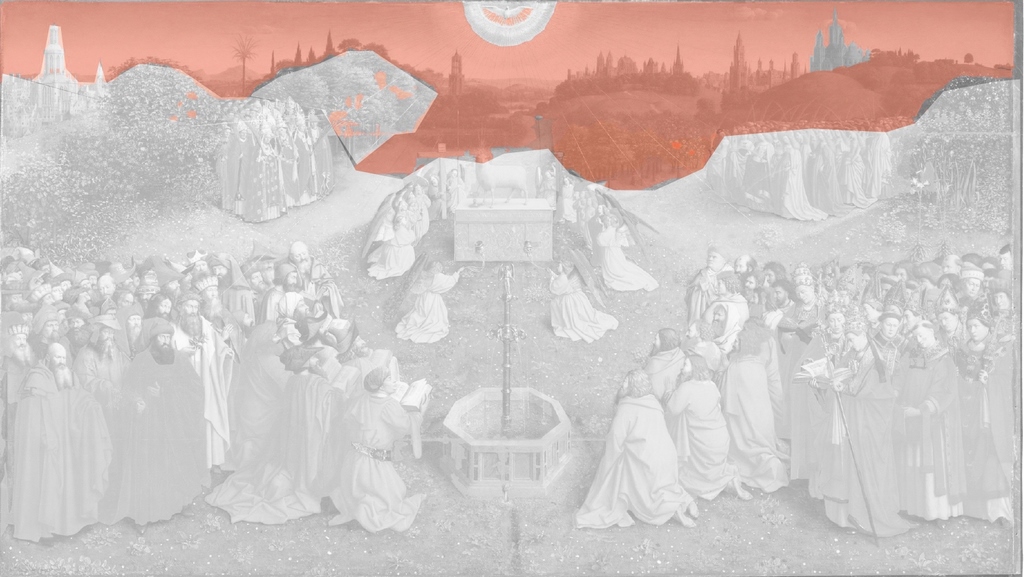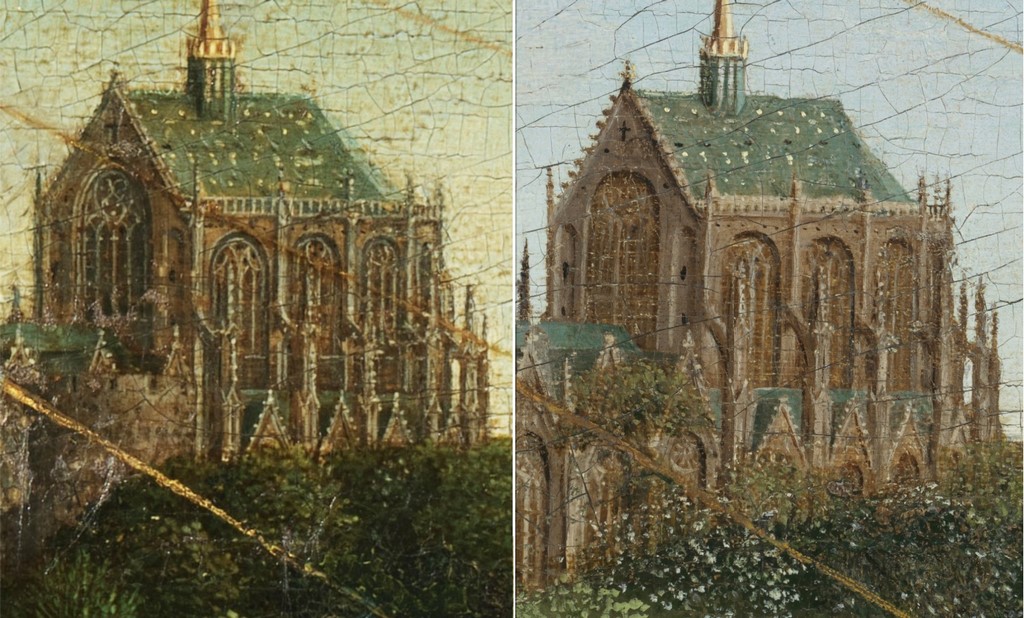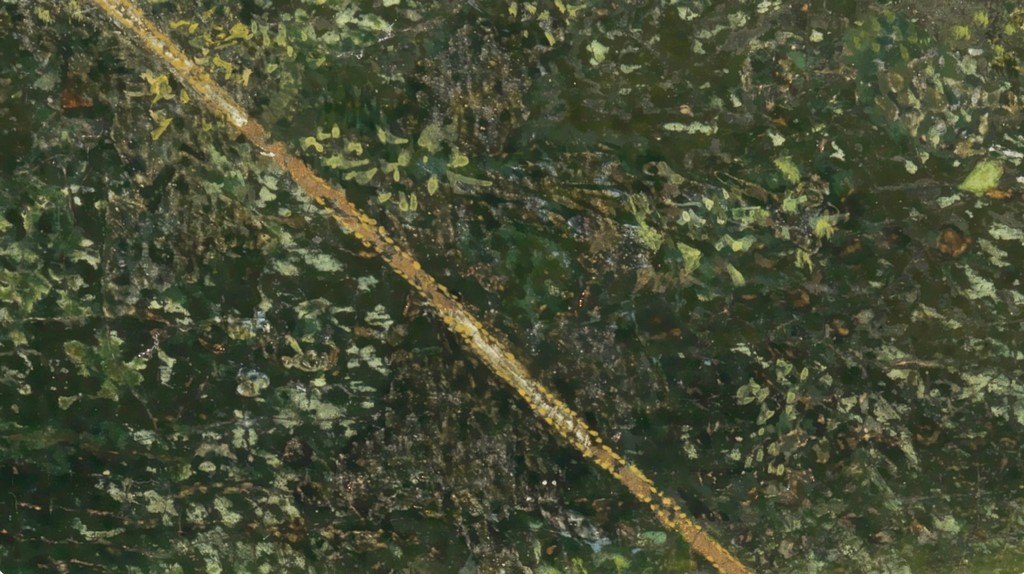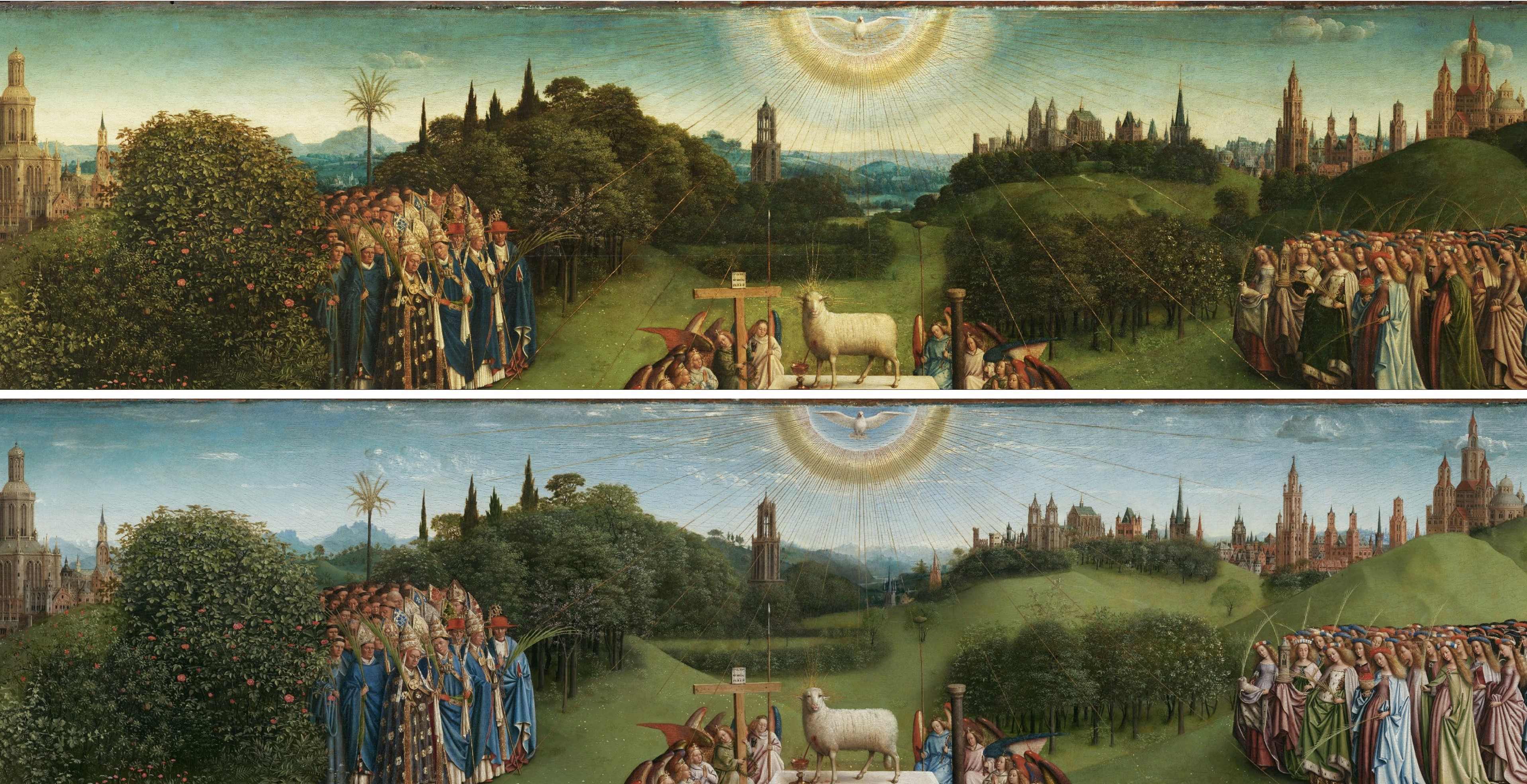Phase 1 of the restoration (the closed altarpiece, 2012-2016), yielded wonderful results. A very old overpainting (16th-century?) was removed and an exceptionally beautiful layer was laid bare, that was attributed unanimously to Jan Van Eyck. In the richly documented publication that resulted from the restoration , various authors explain in detail the difficulties and the scientific results.
Under a different management, phase 2 (open altarpiece, lower register, 2016-january 2020) was catastrophic. The upper part of the Adoration of the Lamb, more or less a quarter of the surface, red in the diagram below, was extensively damaged. The surface was scraped off, supposedly being a “16th-century overpaint… a continuous stratigraphic layer…”. By scraping off the surface, the restorers thought they would achieve a result equivalent to that in phase 1.
 Fig.: (diagram H.V.) unfortunately, the surface in red on the diagram has been completely scraped off with the scalpel, separating layers that were painted shortly the one after the other, an almost impossible task. The scalpel inevitably damaged the underlying layer.
Fig.: (diagram H.V.) unfortunately, the surface in red on the diagram has been completely scraped off with the scalpel, separating layers that were painted shortly the one after the other, an almost impossible task. The scalpel inevitably damaged the underlying layer.
 Fig.: the Adoration of the Lamb, upper part, before and after restoration.
Fig.: the Adoration of the Lamb, upper part, before and after restoration.
Nobody seems to have contested the date of ‘16th-century’. However, no scientific method allows us to date a paint layer as narrowly as has been done here. In the 15th- and 16th -centuries, the painters used the same pallet, restricted to more or less twenty pigments. The elements in a paint layer of the time can be identified, but not dated. Therefore, the so-called ‘16th-century overpainting’, could just as well have been a 15th-century layer. We cannot exclude that it was Jan’s’ work, overpainting his unfinished brother’s project. In contrast to the beautiful result that was obtained in phase 1, the result in phase 2 was of poor quality, flat, and so extensively damaged that it needed an extensive retouching. More or less 50% of the surface laid bare has been rather clumsily retouched. In the following pages you will see many examples of the damaged and retouched areas. It now seems that it is Jan’s original that has been removed, and that it is Hubert’s work, of lesser quality, that has been laid bare.
 Fig.: before and after, fine details are lost.
Fig.: before and after, fine details are lost.
On the website http://closertovaneyck.kikirpa.be one can display on the screen in high definition, a detail before- during- and after restoration. With the option ‘during’, the three images appear simultaneously. One can zoom into the images and make one’s own opinion on the restoration of the surface in any zone. I strongly recommend everyone to do so. No expert is needed for this exercise. The images from closertovaneyck speak for themselves. They are indisputable.
All images in this report are from this website and more particularly from the red zone in the diagram of the Adoration unless mentioned otherwise. For comparison, a few details were chosen in the wing of the Knights of Christ and that of the Pilgrims.
 Fig.: zone under the large Church clumsily retouched: foliage and a beam, both entirely re-painted by the restorers, after removal of the ‘16th-century overpainting’. Nothing is old in that detail.
Fig.: zone under the large Church clumsily retouched: foliage and a beam, both entirely re-painted by the restorers, after removal of the ‘16th-century overpainting’. Nothing is old in that detail.
Once the restoration was finished, in January 2020, and whilst preparing their report and publication , the restorers acknowledged that the situation was much more complex than they had at first thought. They asked for an additional year, in order to further study the Adoration. The restorers write that: …” the study of the hands (Hubert and Jan) could only be done once the restoration was completed, not only when the yellow varnishes had been removed, but also when the 16th-century overpaints had been removed. Only then could a coherent hypothesis be brought forward, with an extra year with extra funding”. Only during the additional year of study do the restorers discover Hubert’s participation. The details in which they recognized Hubert’s hand, had always been visible to the naked eye. They could have recognized them by doing a thorough preliminary study of the Adoration before starting its restoration.
They ascribe to Hubert some faces of lesser quality, and they also saw that two meadows were painted one on top of the other: Jan’s on top of Hubert’s. We will come back to this later. This ‘discovery’ came too late. One quarter of the meadow had already been scraped off. The restorers published their ‘discovery’ of Hubert’s contribution in their publication (2021, Steyaert et al.). In this publication the pages related to the restoration are very limited (p. 9 to 30, many illustrations included). After those first pages, the book essentially describes the painting after restoration, thus after the removal of the ‘16th-century overpainting’, after the damage was done.
After the first pages (p. 9 - 30), a later chapter in the 2021 book explains the difficulties for chemists to describe the stratification of the paint layers. The publication ends with stylistic considerations.
 Fig.: this misleading diagram from the report of 2020 in closertovaneyck, is repeated unchanged in the publication of 2021 (Steyaert et al.). The legend (Fig. IV.3.D.) mentions that the red zones are those “where overpaintings were removed”. The ‘overpainting’ that we discuss here is the one on the upper meadow, architecture, sky, trees, bushes, and the head of the Lamb…In that zone, the complete layer on the surface was erased.
Fig.: this misleading diagram from the report of 2020 in closertovaneyck, is repeated unchanged in the publication of 2021 (Steyaert et al.). The legend (Fig. IV.3.D.) mentions that the red zones are those “where overpaintings were removed”. The ‘overpainting’ that we discuss here is the one on the upper meadow, architecture, sky, trees, bushes, and the head of the Lamb…In that zone, the complete layer on the surface was erased.
This diagram reflects the uncertainties and doubts of the restorers, at a time no suspicion had been raised on Hubert’s contribution. Details on the foreground, such as the large coats, are completely red on the diagram, although most of time, a small late overpainting on a restricted area was seen there. If the restorers had been aware of the underlying work by Hubert, almost the whole composition should have been colored in red, because Jan had indeed almost completely ‘overpainted’ Hubert.
Two advisory committees (one national, one international), in charge of supervising the restoration phase 2, thought they had accomplished their duty when in 2021 the Adoration was returned to the St-Baafs Cathedral. Apparently with everybody’s blessing.
In 2021, a Van Eyck connoisseur started questioning the disappearance from the Adoration of a beautiful detail in the remote landscape, the little ‘Cortewalle’ castle, thought by some to have been the residence of the donors Joos Vijd and Lisbeth Borluut. After I looked into the matter, it became clear to me that much more had been erased than just the castle. The restorers had removed an ‘overpainting’ over about a quarter of the Adoration. Since they erased a beautiful layer, only to lay bare a layer of an obvious lesser quality, one can assume they erased Jan and laid bare Hubert. The weak layer by Hubert was moreover severely damaged, partly by the scalpels. It was clumsily retouched thereafter. At that point, only two or three of us were aware of the extent of the scraping, and the high number of erased details. From there on, the Churchwardens and the Vlaamse Overheid asked me to write a report, which I did in June 2023. The KIK-IRPA wrote a repliek. Both points of view were discussed in a meeting in Ghent on August 30, 2023, organized by the Authorities.
Decisions were taken that I shall discuss in my last chapter. I considered them not sufficient to guarantee the good conservation of the upper register (phase 3) and contacted Jean-Pierre Coppens a longtime researcher on the Ghent Altarpiece. Together we convened a well-attended press conference on December 20, 2023. Furthermore, it seemed necessary to inform a broader public, and we decided to take further steps.
Had it not been for the deliberate choice of transparency adopted from the start of the whole project, with images in high definition from before- during- and after restoration, one would probably not have noticed until much later on the extensive scraping off of the surface during phase 2. As the images before and after capture a precise moment, in contrast, ‘during’ is one snapshot of an evolving situation. We sometimes see that the image ‘during’ much resembles the stage ‘after’ with heavy retouches. This makes us wonder if original paint is always present under the retouches.
